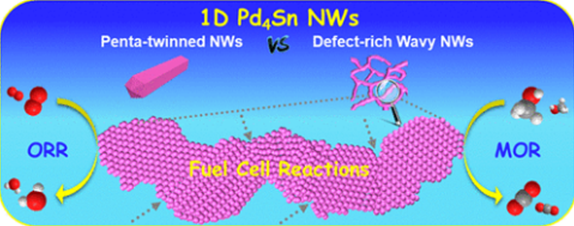Defect Engineering of Palladium−Tin Nanowires Enables Efficient Electrocatalysts for Fuel Cell Reactions
Ying Zhang†,∥, Bolong Huang‡,∥, Qi Shao†, Yonggang Feng†, Likun Xiong§, Yang Peng§, and Xiaoqing Huang*,†(黄小青)
† College of Chemistry, Chemical Engineering and Materials Science, Soochow University, Jiangsu, Suzhou 215123, China
‡ Department of Applied Biology and Chemical Technology, The Hong Kong Polytechnic University, Hung Hom, Kowloon, Hong Kong SAR, China
§ Soochow Institute for Energy and Materials Innovations, Soochow University, Jiangsu, Suzhou 215006, China
∥ These authors contributed equally to this work
Nano Lett. 2019, 19, 6894--6903
The defect engineering of noble metal nanostructures is of vital importance because it can provide an additional yet advanced tier to further boost catalysis, especially for one-dimensional (1D) noble metal nanostructures with a high surface to bulk ratio and more importantly the ability to engineer the defect along the longitudinal direction of the 1D nanostructures. Herein, for the first time, we report that the defect in 1D noble metal nanostructures is a largely unrevealed yet essential factor in achieving highly active and stable electrocatalysts toward fuel cell reactions. The detailed electrocatalytic results show that the Pd–Sn nanowires (NWs) exhibit interesting defect-dependent performance, in which the defect-rich Pd4Sn wavy NWs display the highest activity and durability for both the methanol oxidation reaction (MOR) and the oxygen reduction reaction (ORR). Density functional theory (DFT) calculations reveal that a large number of surface vacancies/agglomerated voids are the driving forces for forming surface grain boundaries (GBs) within Pd4Sn WNWs. These electronic active GB regions are the key factors in preserving the number of Pd0 sites, which are critical for minimizing the intrinsic site-to-site electron-transfer barriers. Through this defect engineering, the Pd4Sn WNWs ultimately yield highly efficient alkaline ORR and MOR. The present work highlights the importance of defect engineering in boosting the performance of electrocatalysts for potentially practical fuel cells and energy applications.

链接:https://pubs.acs.org/doi/10.1021/acs.nanolett.9b02137